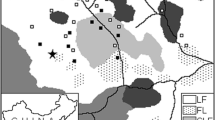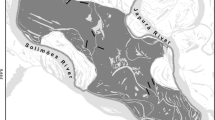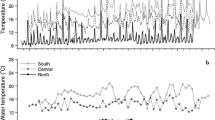Summary
A Virginia population of the forest-dwelling salamander Plethodon cinereus was repeatedly sampled over four years to determine volume and number of prey ingested under varying conditions of moisture and temperature. The proportion of the population on a daily negative energy budget was estimated by comparing actual foraging success with laboratory determined values of energetic requirements at various temperatures.
Prey became “limited” in availability during rainless periods, apparently because salamanders were not able to forage in dry leaf litter. Foraging success increased with increasing rainfall. Food was a “limiting” resource for a majority of the population on most sampling days, as determined by energy budget analysis. While ambient moisture regulated food availability, ambient temperature set the metabolic requirements and assimilation efficiencies for the population. Consequently, food was more limiting on dry, warm days and less so on wet, cool days. These data support the hypothesis that intraspecific competition frequently occurs for a food resource that is periodically limited in availability.
Similar content being viewed by others
References
Burton, T.M.: An analysis of the feeding ecology of the salamanders (Amphibia, Urodela) of the Hubbard Brook Experimental Forest, New Hampshire. J. Herpetol. 10, 187–204 (1976)
Cody, M.L., Diamond, J.M. (eds.): Ecology and evolution of communities. Cambridge, Massachusetts: Harvard Univ. Pr. 1975
Cummins, K.W.: Calorific equivalents for studies in ecological energetics. Pittsburgh, Pennsylvania: Pymatuning Laboratory of Ecology, Univ. Pittsburgh 1967
Fraser, D.F.: Empirical evaluation of the hypothesis of food competition in salamanders of the genus Plethodon. Ecology 57, 459–471 (1976a)
Fraser, D.F.: Coexistence of salamanders in the genus Plethodon: a variation of the Santa rosalia theme. Ecology 57, 238–251 (1976b)
Giesel, J.T.: Reproductive strategies as adaptations to life in temporally heterogeneous environments. Ann. Rev. Ecol. Syst. 7, 57–79 (1976)
Gist, C.S., Crossley Jr., D.A.: The litter arthropod community in a southern Appalachian hardwood forest: numbers, biomass and mineral element content. Amer. Midl. Natur. 93, 107–122 (1975)
Healy, W.R.: Population consequences of alternative life bistories in Notophthalmus viridescens. Copeia 1974, 221–229 (1974)
Jaeger, R.G.: Food as a limited resource in competition between two species of terrestrial salamanders. Ecology 53, 535–546 (1972)
Jaeger, R.G.: Interference or exploitation? a second look at competition between salamanders. J. Herpetol. 8, 191–194 (1974a)
Jaeger, R.G.: Competitive exclusion: coments on survival and extinction of species. BioScience 24, 33–39 (1974b)
Jaeger, R.G.: Plant climbing by salamanders: periodic availability of plant-dwelling prey. Copeia 1978, 686–691 (1978)
Jaeger, R.G.: Microhabitats of a terrestrial forest salamander. Copeia 1980, in press (1980)
Jaeger, R.G., Gergits, W.F.: Intra- and interspecific communication in salamanders through chemical signals on the substrate. Anim. Behay. 27, 150–156 (1979)
Kaplan, D.L.: Exploitative competition in salamanders: test of a hypothesis. Copeia 1977, 234–238 (1977)
Kiester, A.R., Slatkin, M.: A stretegy of movement and resource utilization. Theor. Pop. Biol. 6, 1–20 (1974)
Maiorana, V.C.: Behavior of an unobservable species: diet selection by a salamander. Copeia 1978, 664–672 (1978)
May, R.M.: Mass and energy flow in closed ecosystems: a comment. J. Theor. Biol. 39, 155–163 (1973)
Merchant, H.C.: Estimated energy budget of the red-backed salamander, Plethodon cinereus. New Jersey: Ph.D. Dissertation, Rutgers Univ. 1970
Sayler, A.: The reproductive ecology of the red-backed salamander, Plethodon cinereus, in Maryland. Copeia 1966, 183–193 (1966)
Samuelsen, P.: The home range and homing behavior of the redbacked salamander Plethodon cinereus. Rhode Island: M.S. Dissertation, Univ. Rhode Island 1977
Siegel, S.: Nonparametric statistics for the behavioral sciences, New York: McGraw-Hill 1956
Thurow, G.: Aggression and competition in eastern Plethodon (Amphibia, Urodela, Plethodontidae). J. Herpetol. 10, 277–291 (1976)
Tristram, D.A.: Intraspecific olfactory communication in the terrestrial salamander Plethodon cinereus. Copeia 1977, 597–600 (1977)
U.S. Department of Commerce: Climatological Data. vols. 80–83 (1970–1973)
Author information
Authors and Affiliations
Rights and permissions
About this article
Cite this article
Jaeger, R.G. Fluctuations in prey availability and food limitation for a terrestrial salamander. Oecologia 44, 335–341 (1979). https://doi.org/10.1007/BF00545237
Received:
Issue Date:
DOI: https://doi.org/10.1007/BF00545237




